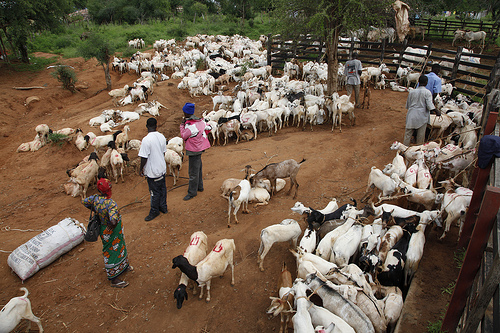USDA Science: In Support of Feed the Future and Global Food Security
This post is part of the Science Tuesday feature series on the USDA blog. Check back each week as we showcase stories and news from the USDA’s rich science and research portfolio.
As part of the U.S. government’s global hunger and food security initiative called Feed the Future, USDA is building collaborative scientific partnerships with nearly a dozen organizations that will help U.S. and African goat producers enhance goat breeding and productivity.
Feed the Future is part of a multilateral effort launched at the L’Aquila World Summit on Food Security in 2009 to accelerate progress toward the Millennium Development Goal of halving the proportion of people living in extreme poverty and suffering from hunger by 2015. The program enables affected governments and their people to take the lead in developing and implementing food security solutions. These “country-driven” strategies give ownership and accountability, while tackling the root causes of hunger and poverty. Working with the U.S. Agency for International Development (USAID), USDA offers strong competencies in capacity development, food assistance, research and technology transfer in support of Feed the Future.
On the goat project, funded by USAID’s Norman Borlaug Commemorative Research Initiative, African research partners and others will collect and share goat DNA and performance measures (i.e., heat tolerance, milk yield, parasite resistance, growth rate) from more than 20 distinct goat populations from Africa, the United States, the Middle East and other portions of Asia, and Brazil. Researchers will identify unique genes in each population and develop genetic preservation plans. Considering how breeds differ in performance traits like milk yield and parasite resistance, this project will associate those differences with the DNA, enabling farmers to more quickly breed healthier, more productive goats than with observing performance traits alone. For example, some Kenyan goat farmers imported high milk producing Swiss Toggenburg goats to cross with native goats. First generation crosses produced enough milk to feed the owners’ families and sell for income. But the crossbreed goats were found to be easily infected with parasites. This project will help eliminate those types of common pitfalls. Modern tools relating DNA to performance traits across multiple breeds will mean better breeding decisions and healthier, more productive goats for a sustainable food supply.

African goat market seen on a Farm Africa-led Mwingi District tour for goat improvement project partners. (Photo credit: Fulani Media, International Livestock Research Institute).
In Feed the Future focus countries, fish and livestock are critical to communities, livelihoods, nutritional status, and economic development. Globally, the livestock sector employs 1.3 billion people and contributes up to 50% of global agricultural GDP. By 2025, global meat demand is expected to grow by almost 40%.
USDA’s Agricultural Research Service (ARS) is contributing international research program management expertise, as well as research and technical expertise on this project. ARS animal geneticists Curt Van Tassel and Tad Sonstegard, as well as Brian Sayre, Associate Professor at the Department of Biology at Virginia State University (VSU), bring a wealth of research and extension service expertise. The multi-level collaborations fostered by the Feed the Future model promise real food security solutions and tangible results to farmers and people all around the world.
To learn more about Feed the Future, please visit www.feedthefuture.gov.
